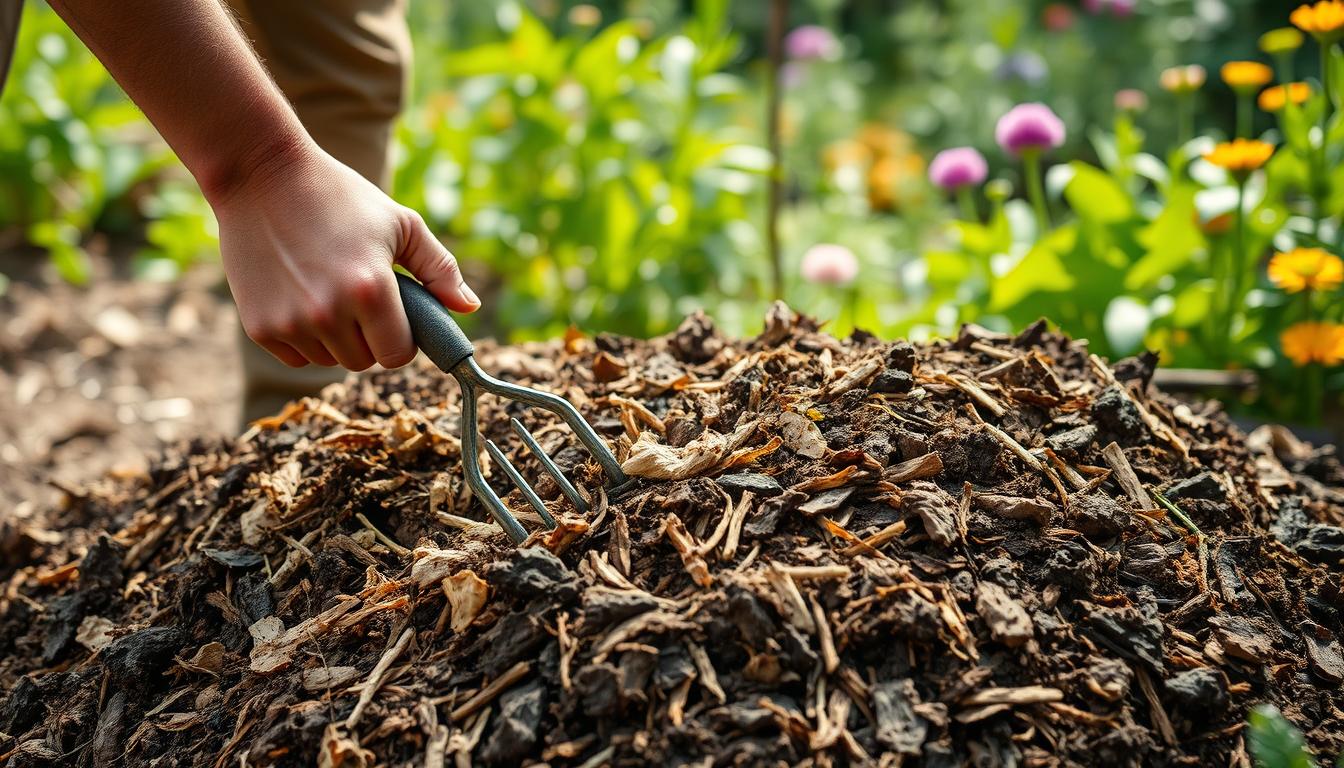Keeping your compost pile healthy is key for gardeners and those who care about the environment. Many wonder how often to turn or mix compost.
Turning your compost at the right time can greatly affect how well it breaks down, making the final product better.
Turning compost too much can mess up the breakdown process. Not turning it enough can cause bad smells and anaerobic conditions.
So, what’s the best time to turn it? The answer varies based on the composting method, pile size, and what you’re composting.
In this article, we’ll look at the best ways to turn your compost pile. This will help you get the perfect balance for healthy breakdown.
Key Takeaways
- Understanding the importance of compost turning frequency
- Factors influencing the optimal compost turning schedule
- Best practices for maintaining a healthy compost pile
- How to avoid common mistakes in compost turning
- Tips for achieving optimal decomposition
The Science Behind Compost Turning
Composting works best when you know about oxygen, microorganisms, and heat.
These things help keep your compost pile healthy and working well.
Why Oxygen Matters in Decomposition
Oxygen is key in breaking down compost. It affects the kind of microbes that grow in the pile.
Aerobic vs. Anaerobic Breakdown
Aerobic breakdown needs oxygen and happens fast. Anaerobic breakdown, without oxygen, is slower and can smell bad.
Aerobic conditions are better for composting because they help good microbes grow.
Oxygen’s Role in Speeding Decomposition
Oxygen speeds up decomposition by helping aerobic microbes work.
These microbes break down materials quickly when there’s enough oxygen, making composting faster.
Microbial Activity and Heat Generation
Microbes drive the composting process. They break down materials and make heat.
Beneficial Microorganisms at Work
Good microbes, like bacteria and fungi, break down organic stuff.
They do best in oxygen-rich environments, where they can efficiently process complex materials.
The Thermal Cycle of Compost
The compost pile goes through a heat cycle. Temperatures rise as microbes work more.Turning the pile regularly keeps temperatures right, between 130°F and 140°F.
This kills off bad stuff and seeds.
Knowing the science of compost turning helps you manage your pile. This way, you get efficient decomposition and quality compost.
How Often Should I Turn or Mix My Compost?
Composting works best when you turn and mix the materials often. The right schedule depends on your composting method.
Hot Composting Frequency Guidelines
Hot composting is quick and needs more turning. It uses high temperatures to break down materials fast.
The 3-Day Rule for Maximum Efficiency
Some composters turn their pile every 3 days for the best results. An expert says,
“Turning the compost pile regularly is crucial for maintaining oxygen flow and speeding up the decomposition process.”
Turning often keeps the pile aerated. This helps microorganisms break down the materials well.
Weekly Turning for Balanced Results
Turning weekly is a good middle ground. It keeps the pile aerated and speeds up decomposition without too much work.
Weekly turning is often considered a sweet spot for many hot composters, as it balances effort with results.
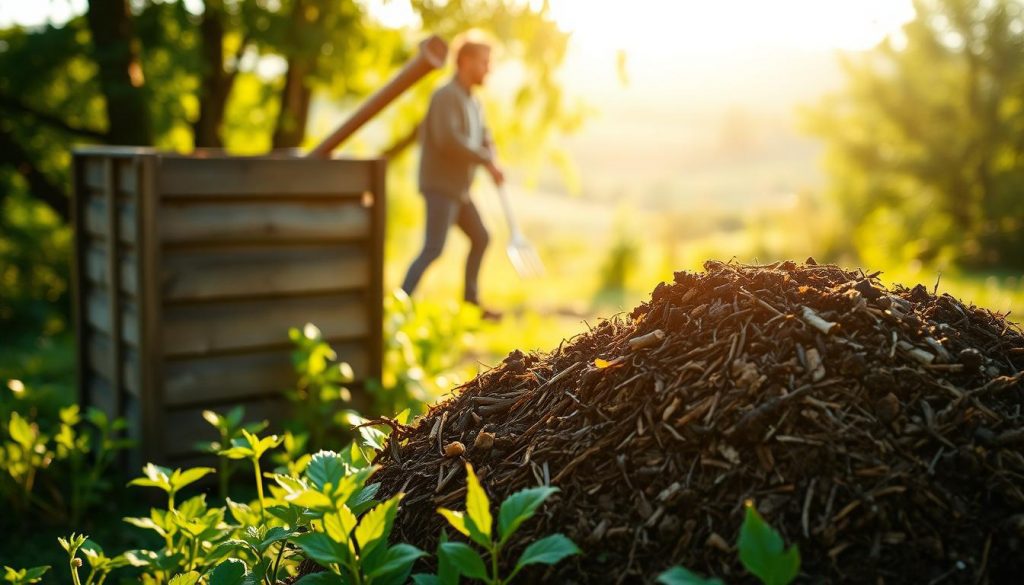
Cold Composting Turning Schedule
Cold composting is slower and needs less care. Still, some turning is good to avoid anaerobic conditions.
Monthly Turning Approach
For cold composting, turning monthly is enough. This keeps the pile aerated without constant effort. It’s ideal for those who compost lightly.
Seasonal Turning Strategy
Another way for cold composting is to turn seasonally. Turn the compost at the start of each season.
This strategy allows for periodic aeration and mixing without needing to turn often.
Factors That Affect Your Compost Turning Schedule
Knowing what affects your compost turning schedule is key to a healthy pile.
Several factors can change how fast things decompose. Being aware of these can improve your composting.
Compost Pile Size and Composition
The size and what’s in your compost pile matter a lot.
A bigger pile holds heat well but might need more turns. This ensures everything breaks down evenly.
Green-to-Brown Ratio Impact
The green-to-brown ratio is very important. You need a mix of “green” stuff like food scraps and “brown” stuff like leaves. Try for 2/3 “brown” and 1/3 “green” materials for best results.
Particle Size Considerations
The size of your compost’s particles also matters. Smaller pieces break down quicker but can get too dense and block air.
Cutting your materials before adding them helps keep things balanced.
Weather and Seasonal Considerations
Weather and the season can change how often you need to turn your compost. In wet times, you might need to turn it more often to avoid bad smells.
In dry times, watch the moisture.
Available Time and Physical Ability
How much time you have and your physical strength also play a part. If you’re short on time or not very strong, you might need a simpler composting method.
Or you might need to adjust your expectations.
Using a compost tumbler can make turning easier. Also, think about your schedule and adjust your composting to keep it consistent and effective.
Signs Your Compost Needs Turning
Knowing when to turn your compost is key to a successful composting process. Regular checks help spot problems early.
This keeps your compost healthy and useful.
Temperature Indicators
Temperature is crucial in composting. It shows how active the microbes are.
Using a Compost Thermometer
A compost thermometer is essential for checking your pile’s temperature. Temperatures between 130°F and 140°F mean it’s actively composting.
Regular checks help you know if it’s too hot or cold.
Temperature Plateaus and Drops
If the temperature stays the same or drops a lot, it’s time to turn the pile. This could mean the microbes are slowing down.
It might be due to too little oxygen or too much moisture.
Odor Cues
Odors are a big clue about your compost’s health. While some smells are normal, others are not.
Normal vs. Problematic Smells
A good compost pile smells earthy. Pungent or ammonia-like odors mean there’s a problem.
Addressing Ammonia or Sulfur Odors
Ammonia or sulfur smells mean there’s too much nitrogen. Turning the pile and adding more carbon can fix it.
Visual Indicators
Looking at your compost is also important. Watch for mold growth, too much moisture, or dry spots.
These signs mean it’s time to turn the pile or make other changes.
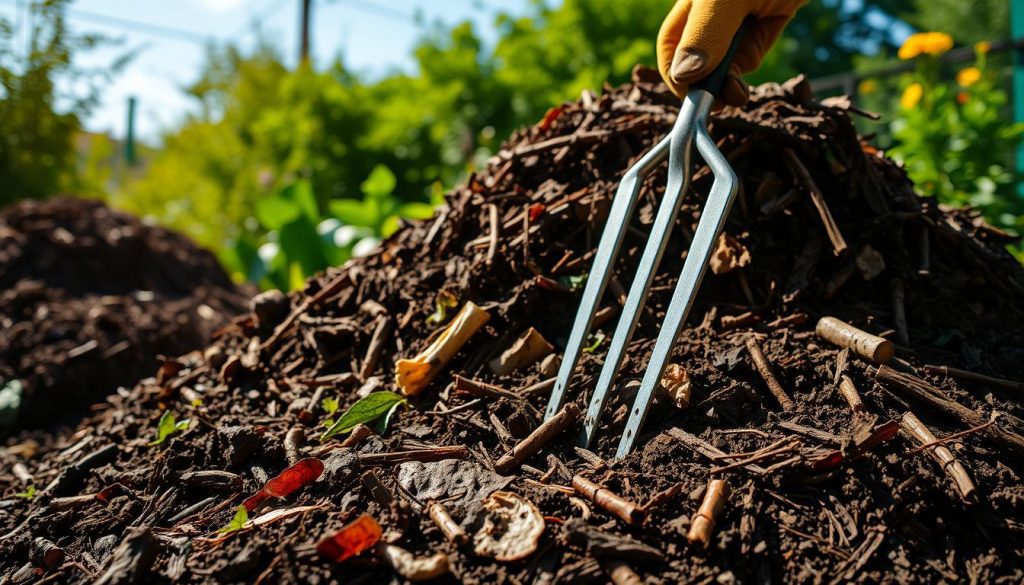
By watching for these signs and acting on them, you can keep your compost healthy.
Regular turning based on these signs will give you top-notch compost for your garden.
Essential Tools for Effective Compost Turning
To turn or mix compost well, you need the right tools. The right tools make the job easier and ensure the compost pile gets enough air.
This air is key for the compost to break down properly.
Having the right tools can make a big difference in compost turning. Whether you have a small backyard compost pile or a big one, the tools you use are crucial.
They help you reach your composting goals.
Manual Turning Tools
Manual tools are great for small compost piles or if you like doing things by hand. They give you control over the compost pile and are often cheaper.
Pitchforks and Garden Forks
Pitchforks and garden forks are top choices for turning compost. They are easy to use and let you aerate the compost pile well.
A pitchfork is especially good for turning the compost gently without damaging it.
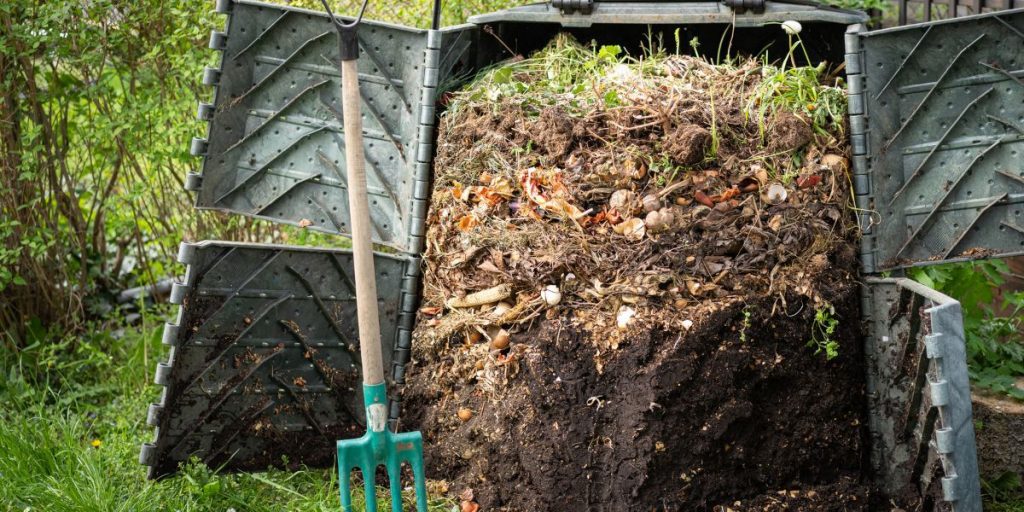
Specialized Compost Aerators
Specialized compost aerators are made just for turning compost. They are more efficient than forks, especially for big piles.
They help speed up the composting process by adding air.
“The use of appropriate tools in compost turning is not just about ease; it’s about creating an optimal environment for microbial activity.”
Compost Tumblers and Mechanical Options
For big compost piles or if you prefer machines, compost tumblers and mechanical mixers are good.
They make turning compost easier and save a lot of work.
Choosing the Right Tumbler Size
When picking a compost tumbler, choose one that fits your needs. A tumbler that’s too small won’t be efficient, and one that’s too big is hard to use.
| Tumbler Size | Compost Capacity | Ideal User |
|---|---|---|
| Small | 1-2 cubic feet | Small households |
| Medium | 2-4 cubic feet | Average households |
| Large | 4+ cubic feet | Large households or commercial |
Motorized Compost Mixers
Motorized compost mixers are great for big composting jobs. They make turning compost much easier and are perfect for big operations.
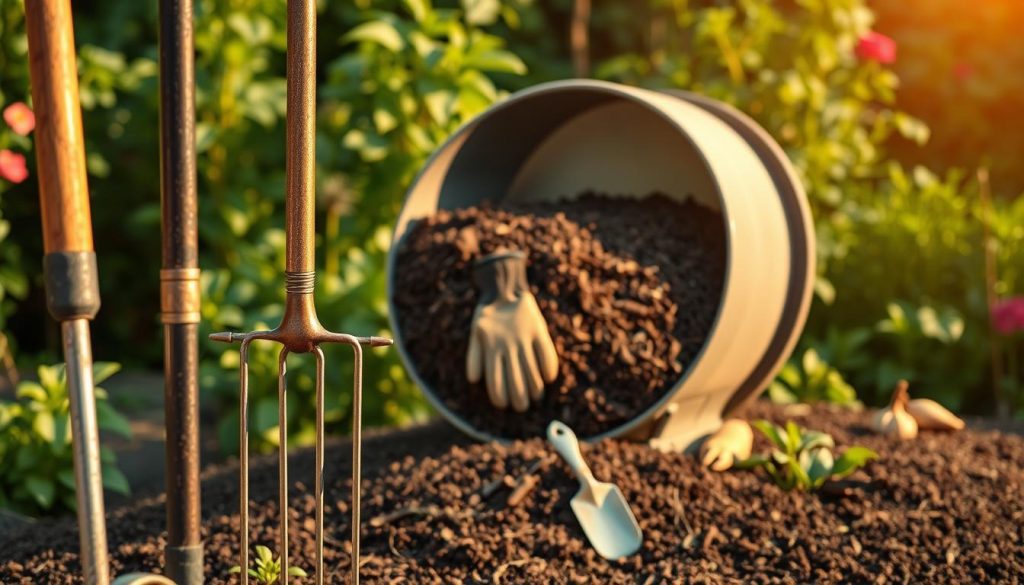
Step-by-Step Guide to Properly Turn Your Compost
To compost well, you need to turn your pile in a certain way. This makes the compost decompose faster and keeps it full of nutrients.
Experts say, “Regular turning is the key to maintaining optimal composting conditions.”
Preparation Steps
Before you start, get ready with two important steps:
Gathering Your Tools
Make sure you have the right tools. A pitchfork or compost turning tool is best for mixing the pile.
Choose a tool that feels comfortable in your hands and is suitable for the size of your compost pile.
Creating Working Space
Clear the area around your compost pile. This makes it easier to turn without spilling.
Aim for at least a few feet of clearance.
The Turning Technique
The way you turn your compost matters a lot. There are two main methods:
Inside-Out Method
This method moves outer materials to the center. It ensures even decomposition.
This way, the outer layers get to break down in the pile’s center.
Layer-by-Layer Approach
You can also turn your compost layer by layer. This method involves dismantling and reassembling the pile.
This approach helps in maintaining uniformity in the decomposition process.
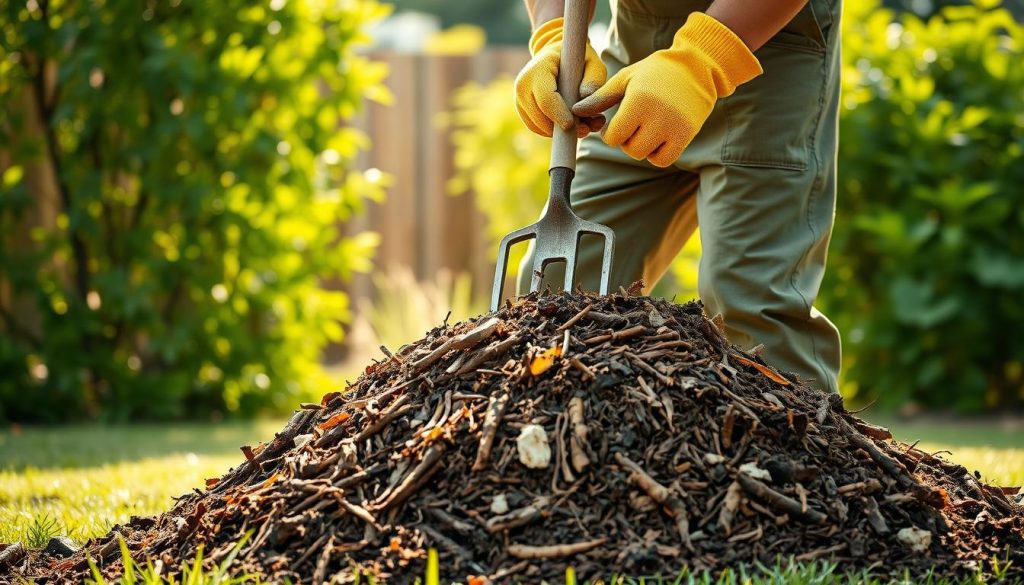
Post-Turning Care
After turning, check a few things to keep the process going right:
Moisture Assessment and Adjustment
Check the pile’s moisture after turning. It should be like a damp sponge.
Add water if it’s too dry, or mix in dry materials if it’s too wet.
Covering Considerations
Think about covering your pile after turning. A tarp or straw can help keep it warm and moist.
Experienced gardeners say, “Covering the pile helps in maintaining the optimal conditions for decomposition.”
Seasonal Adjustments to Your Compost Turning Schedule
Adapting your compost turning schedule to the seasons is crucial. Each season brings different temperatures, moisture, and microbial activities.
These factors affect how often you should turn your compost.
Spring and Summer Turning Frequency
Spring and summer are when composting speeds up. Warmer temperatures and more microbial activity mean you’ll need to turn your compost more often.
Managing High Heat Periods
Summer’s peak can make compost piles very hot. Turning the pile during these times helps cool it down. This prevents the death of beneficial microbes.
Try to turn your compost every 3-5 days when it’s extremely hot.
Balancing Moisture During Dry Spells
Summer dry spells can dry out your compost. Regular turning helps keep moisture levels right.
It mixes drier outer materials with the wetter inner core.
Fall and Winter Turning Considerations
Fall and winter slow down the composting process due to colder temperatures. But, you can’t ignore your compost pile completely.
Cold Weather Strategies
In colder months, insulate your compost pile to keep it warm. Turning it less often is okay, but still check on it now and then.
Snow and Freezing Conditions Approach
If your compost pile is frozen or snow-covered, wait until it warms up before turning it.
Turning a frozen pile can harm the microbes and slow down composting when it starts again.
Troubleshooting Common Compost Turning Problems
Compost turning problems can be frustrating, but most issues have simple solutions. Effective composting relies on maintaining the right conditions for decomposition.
Turning the compost is a crucial part of this process.
Dealing with a Soggy Compost Pile
A soggy compost pile is often a sign of too much moisture. To fix this, add dry materials like straw or shredded newspaper to absorb excess water.
Make sure your compost pile has a mix of “green” and “brown” materials. Regularly turning the compost improves aeration.
Fixing a Dry, Inactive Pile
If your compost pile is dry and inactive, it may be due to a lack of moisture or nitrogen. Check the moisture level and add water if necessary.
Adding “green” materials high in nitrogen, such as food scraps or grass clippings, can stimulate microbial activity.
Managing Pests During Turning
Pests can be a problem in compost piles, but there are ways to manage them. Here are some tips:
- Ensure the pile is not too wet or too dry.
- Add a mix of “green” and “brown” materials.
- Avoid adding meat, dairy, or oily foods that attract pests.
Deterring Rodents and Larger Animals
To deter rodents and larger animals, use a secure compost bin. Avoid adding food scraps that are high in protein or fat.
Beneficial vs. Problematic Insects
Not all insects in your compost are problematic. Beneficial insects like beetles and ants help break down organic matter.
However, pests like flies and rodents can be a nuisance. Monitor your compost regularly to identify and address any issues.
Alternative Approaches to Traditional Compost Turning
Looking for something different from traditional compost turning? There are many alternative methods that are flexible and efficient.
These options meet various needs and preferences, offering new ways to compost.
No-Turn Composting Methods
No-turn composting is a low-maintenance choice. It doesn’t need regular turning. Instead, it focuses on setting up the compost pile correctly and managing the materials.
Layering Techniques for Passive Composting
Layering techniques involve stacking ‘green’ and ‘brown’ materials in a specific order. This method encourages passive decomposition.
It ensures the right balance of carbon and nitrogen and keeps the pile aerated.
Using Compost Activators Instead of Turning
Compost activators, like nitrogen-rich substances or microbial inoculants, speed up decomposition without turning.
They keep the microbes active and quicken the composting process.
Vermicomposting Maintenance
Vermicomposting, or worm composting, needs its own care routine. It involves managing worm bins and collecting the compost they produce.
Worm Bin Harvesting vs. Turning
Harvesting from worm bins means taking out the compost while leaving the worms.
This is different from turning, as it doesn’t mix the materials.
Combining Worm Composting with Traditional Methods
Some people mix vermicomposting with traditional composting. This hybrid method combines the best of both worlds.
It can improve the quality and efficiency of the compost.
Conclusion
Turning and maintaining your compost pile is key for good decomposition. It makes your soil rich and ready for your garden.
Knowing when to turn your compost helps it work better and avoids problems.
Things like the size of your compost, what’s in it, the weather, and how much time you have affect when to turn it.
Checking the temperature, smell, and look of your compost helps. This ensures it stays healthy and breaks down well.
Following the advice given will help you succeed with composting. It’s not just good for the environment. It also makes your soil better, helping your plants grow strong and healthy.
With a bit of practice and patience, you’ll get good at composting. Your garden will grow better because of it.
Keeping your compost pile in good shape is a simple way to make your garden better and more sustainable.

